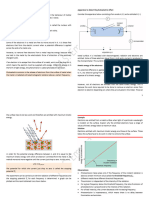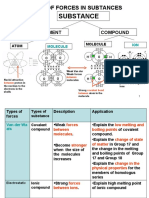Ionisation Energies
Ionisation Energies
Uploaded by
throwawayemailorangesCopyright:
Available Formats
Ionisation Energies
Ionisation Energies
Uploaded by
throwawayemailorangesCopyright
Available Formats
Share this document
Did you find this document useful?
Is this content inappropriate?
Copyright:
Available Formats
Ionisation Energies
Ionisation Energies
Uploaded by
throwawayemailorangesCopyright:
Available Formats
Ionisation energies
Ionisation
energy measures how
easily an atom loses
positive
-
electrons to form lons
first Ionisation
energy the
energy required to remove
· -
oneelectron fromeachatominonemole of gaseou
a is
lonisation
factors
affecting energy
·
first electron lost will be the
highest energy level and
will experience the least attraction from the nucleus
factors
affecting this :
·
Atomic radius -
The distance between the
greater
nucleus and the outer electrons the less the nuclear
,
attraction
Nuclear
charge The more protons there are in the
-
nucleus of the atom the the attraction
the
greater
the outer
,
between nucleus and electrons
·
Electron
sheilding/electrons are
negatively charged
and so inner-shell electrons repel outer-shell electrons)
-
The repulsion called the
shelding
affect reduces the
attraction between the nucleus and the outer electrons
Successive conisation energies
seconed conisation energy is higher than the first
↳ Nuclear attraction on electrons is increased
·
seconed Ionisation
remaining
·
The
energy
-required to energy
remove one electron from each atom in one mole of
It ions of an element to form one mole of
gaseous 2+
ions
gaseous
successive Ionisation energies and shells
large Jumps in Ionisation energies show that a new
-
energy level has been reached
making predictions from successive conisation energies
·
predictions that can be made :
The number of electrons in the outer shell
·
of the element in the periodic table
group
the
·
identity of an element
You might also like
- 4.6 Nuclear Fission and FusionDocument12 pages4.6 Nuclear Fission and FusionRajat RavikumarNo ratings yet
- Unit 5 Electrons AeDocument34 pagesUnit 5 Electrons AeRomu RaiNo ratings yet
- Ion EnergiesDocument39 pagesIon Energiesabashir7852No ratings yet
- Chapter 7 Periodic Properties of ElementsDocument42 pagesChapter 7 Periodic Properties of ElementsClaire SanshineNo ratings yet
- Lecture3 2019 MPDocument12 pagesLecture3 2019 MPpumaNo ratings yet
- CH 7Document2 pagesCH 7Heather SiuNo ratings yet
- Eng SciDocument1 pageEng SciAzaa anuarNo ratings yet
- 11 It The Production, Properties and Interactions of X-RaysDocument14 pages11 It The Production, Properties and Interactions of X-Raysroma ulinaNo ratings yet
- Science9.Chapter5.Lesson1 - Ionic BondingDocument51 pagesScience9.Chapter5.Lesson1 - Ionic BondingടHՕՕꝄedкƲȠNo ratings yet
- 5DP Ionisation EnergiesDocument17 pages5DP Ionisation EnergiesVaida MatulevičiūtėNo ratings yet
- Trends & The Periodic TableDocument34 pagesTrends & The Periodic TableAnita KapadiaNo ratings yet
- Transes ECEDocument14 pagesTranses ECEI AM CHESCA (IamChesca)No ratings yet
- L03 Atomic Structure and Interatomic BondingDocument20 pagesL03 Atomic Structure and Interatomic BondingVivek vermaNo ratings yet
- PDF Document 2Document14 pagesPDF Document 2Abikala McDonaldNo ratings yet
- Ionization PotentialsDocument1 pageIonization PotentialsJoshua SeñarosaNo ratings yet
- General Physics 2Document18 pagesGeneral Physics 2Nea Faith L. LEMERICNo ratings yet
- Interactionofradiation Drvandana 110828021807 Phpapp01Document47 pagesInteractionofradiation Drvandana 110828021807 Phpapp01Kumkumo Kussia KossaNo ratings yet
- (New Specification) (Document34 pages(New Specification) (Anuki PereraNo ratings yet
- Quantum PhysicsDocument16 pagesQuantum PhysicsBobby BichumNo ratings yet
- 4.2: Variation of Physical and Chemical PropertiesDocument68 pages4.2: Variation of Physical and Chemical PropertiesAnisha Syazwana Binti RoslyNo ratings yet
- Electronic Configurations, Orbital Diagrams & Periodic TableDocument3 pagesElectronic Configurations, Orbital Diagrams & Periodic TableSam SoftNo ratings yet
- Electrons in Atoms.Document62 pagesElectrons in Atoms.Md.Tanjim reza TurjoNo ratings yet
- Ionisation EnergyDocument23 pagesIonisation EnergyNurfarhanah KNo ratings yet
- Periodic Trends: ElectronegativityDocument2 pagesPeriodic Trends: ElectronegativityZaara RyeenNo ratings yet
- Chapter 7 of MechatronicsDocument15 pagesChapter 7 of MechatronicsSyed Basith MNo ratings yet
- Modern Physics: Join HP GurukulDocument11 pagesModern Physics: Join HP Gurukulaniketagarwal6350No ratings yet
- Ionisation and Energy LevelsDocument23 pagesIonisation and Energy LevelsAzuralianNo ratings yet
- Trends in The Periodic TableDocument41 pagesTrends in The Periodic TablespsarathyNo ratings yet
- AtomicstructureflowchartDocument1 pageAtomicstructureflowchartprinceai0501No ratings yet
- IgCse Physics NotesDocument6 pagesIgCse Physics Notessalvatourelena25353No ratings yet
- Lesson 4 Updated VersionDocument17 pagesLesson 4 Updated VersiongenenaomarNo ratings yet
- 6 4IonizEnergyDocument1 page6 4IonizEnergyShehbaz YaseenNo ratings yet
- 2 11 Atomic Structure and Mass SpectrometryDocument6 pages2 11 Atomic Structure and Mass SpectrometryAbdur RehmanNo ratings yet
- Engineering Material Presentation: Presented To: Engr. Nadeem Hassan Presented By: Abdul Rauf 2k17-Che-17Document70 pagesEngineering Material Presentation: Presented To: Engr. Nadeem Hassan Presented By: Abdul Rauf 2k17-Che-17Abdul Rauf ChNo ratings yet
- Chapter 19.1-Ionization&electron AffinityDocument15 pagesChapter 19.1-Ionization&electron AffinityWENDY MENDIOLANo ratings yet
- HalflifeDocument4 pagesHalflifemdnahidulhoquenhNo ratings yet
- Electron Configurations LessonDocument19 pagesElectron Configurations LessonWARREN ESCAPENo ratings yet
- Atom Atom: Electron, The Proton and The NeutronDocument29 pagesAtom Atom: Electron, The Proton and The Neutronrehab ebraheemNo ratings yet
- Physical ScienceDocument10 pagesPhysical ScienceLaisa ParedesNo ratings yet
- Thumbnail SlideDocument253 pagesThumbnail SlideAayush NareNo ratings yet
- Trends in The Periodic TableDocument25 pagesTrends in The Periodic TableHanna GalatiNo ratings yet
- Electron Theory: Akd10102: Electrical Fundamendal 1Document14 pagesElectron Theory: Akd10102: Electrical Fundamendal 1Mirza ImanNo ratings yet
- GenPhys 2Document18 pagesGenPhys 2Nea Faith L. LEMERICNo ratings yet
- PHOTOELECTRICEFFECT1Document33 pagesPHOTOELECTRICEFFECT1abahynNo ratings yet
- Introduction To Electrical ReviewerDocument17 pagesIntroduction To Electrical ReviewerTrisha CieloNo ratings yet
- Engineering Chemistry Notes UNIT 4Document9 pagesEngineering Chemistry Notes UNIT 4Nivetha ENo ratings yet
- Untitled Notebook PDFDocument28 pagesUntitled Notebook PDF石上 優No ratings yet
- General Physics II q3Document7 pagesGeneral Physics II q3Glaiza Mae GalizaNo ratings yet
- Nuclear Physics Part 1 20240925Document11 pagesNuclear Physics Part 1 20240925jurassicworldplayerxNo ratings yet
- 2A Ionization EnergyDocument13 pages2A Ionization Energythe-anonymous poetNo ratings yet
- Periodic PropertiesDocument30 pagesPeriodic Propertiescleofe omas-asNo ratings yet
- Aviation Technical TrainingDocument203 pagesAviation Technical TrainingJuliusNo ratings yet
- Trends & The Periodic TableDocument34 pagesTrends & The Periodic TableJoseph ZhangNo ratings yet
- Ionisation Energy: A Guide For A Level StudentsDocument37 pagesIonisation Energy: A Guide For A Level StudentsLalitha KurumanghatNo ratings yet
- ElectricalDocument3 pagesElectricalArgha ChakrabortyNo ratings yet
- Periodic TrendsDocument35 pagesPeriodic TrendslojeNo ratings yet
- Type of Forces 1 Notes 2010Document26 pagesType of Forces 1 Notes 2010Mohd Iruan JanalNo ratings yet
- Ap Chem Unit 1 Review PacketDocument10 pagesAp Chem Unit 1 Review Packetapi-77411869No ratings yet
- Topic 2 Part2 Atomic Structure and The Periodic Table 2A Ionisation EnergiesDocument7 pagesTopic 2 Part2 Atomic Structure and The Periodic Table 2A Ionisation Energiesd0362688No ratings yet
- Lecture 01 Fundamentals of ElectricityDocument4 pagesLecture 01 Fundamentals of ElectricityOnofre Algara Jr.No ratings yet
- Access NCERT Solutions For Class 12 Physics Chapter 13Document33 pagesAccess NCERT Solutions For Class 12 Physics Chapter 13Raina RamNo ratings yet
- Paper 2 Code 2 SolutionDocument40 pagesPaper 2 Code 2 SolutionAtul KunduNo ratings yet
- Phy Spec-1Document2 pagesPhy Spec-1phliewNo ratings yet
- Invitation To Direct Insight Meditation by SoeWinHtutDocument44 pagesInvitation To Direct Insight Meditation by SoeWinHtutapi-19882018No ratings yet
- Espartero Activity 2 EnergyDocument3 pagesEspartero Activity 2 EnergyJahrel DaneNo ratings yet
- Multiple Choice Questions Topic 10Document100 pagesMultiple Choice Questions Topic 10Dylan ATKINSNo ratings yet
- Adv p6Document6 pagesAdv p6EXID ILY143No ratings yet
- PHY301 Updated HandoutsDocument246 pagesPHY301 Updated HandoutsabusufyanNo ratings yet
- Eim NC Ii CBLMDocument12 pagesEim NC Ii CBLMLen TsukimoriNo ratings yet
- IB Physics Revision NotesDocument31 pagesIB Physics Revision NotesBig Long67% (3)
- Class 12 Physics Part 2 PDFDocument239 pagesClass 12 Physics Part 2 PDFultimate desireNo ratings yet
- New Text DocumentDocument14 pagesNew Text Documentbegasis295No ratings yet
- IGCSE Atomic StructuresDocument4 pagesIGCSE Atomic StructuresNikki MaxwellNo ratings yet
- Chemistry JeopardyDocument54 pagesChemistry Jeopardyohoegh8985No ratings yet
- Biology The Dynamic Science 4th Edition Russell Solutions ManualDocument25 pagesBiology The Dynamic Science 4th Edition Russell Solutions ManualDebraLarsoncbag100% (65)
- The Ideas About Atom and Atomic ModelDocument2 pagesThe Ideas About Atom and Atomic ModelJea Lyca GuiñetaNo ratings yet
- Chemistry Modul Theory AtomDocument17 pagesChemistry Modul Theory Atomlevi yunitasariNo ratings yet
- The Atom For AnatomyDocument106 pagesThe Atom For AnatomyAlexandra B. FloresNo ratings yet
- WPH04 01 Que 20150113 PDFDocument28 pagesWPH04 01 Que 20150113 PDFDaianna PeirisNo ratings yet
- Atomic Structure and Periodicity - Jack Barrett - 2002Document188 pagesAtomic Structure and Periodicity - Jack Barrett - 2002Cayo Farias100% (2)
- James ChadwickDocument10 pagesJames ChadwickdthabatahNo ratings yet
- LAMPF-Its Origins, History, and AccomplishmentsDocument22 pagesLAMPF-Its Origins, History, and AccomplishmentsAlejandro SevillaNo ratings yet
- Distinguishing Between Atoms: Section ReviewDocument2 pagesDistinguishing Between Atoms: Section ReviewAzul GomezNo ratings yet
- 1.17 - Principles of Gamma-Ray Spectroscopy and Applications in Nuclear Forensics - Chemistry LibreTextsDocument4 pages1.17 - Principles of Gamma-Ray Spectroscopy and Applications in Nuclear Forensics - Chemistry LibreTextsMohammed Khaja Moinuddin SiddiquiNo ratings yet
- Year 12 - Physics - Passcards - Digital - Press - Rev PDFDocument108 pagesYear 12 - Physics - Passcards - Digital - Press - Rev PDFZhaoHua Zheng100% (1)
- Carbohydrates, Proteins, Nucleic Acids and Natural DyesDocument332 pagesCarbohydrates, Proteins, Nucleic Acids and Natural DyesLyra AnthonyNo ratings yet
- Review Questions 4 PDFDocument6 pagesReview Questions 4 PDFUmme AbdullahNo ratings yet
- In All Its GloryDocument10 pagesIn All Its GloryKeren HZNo ratings yet

























































































